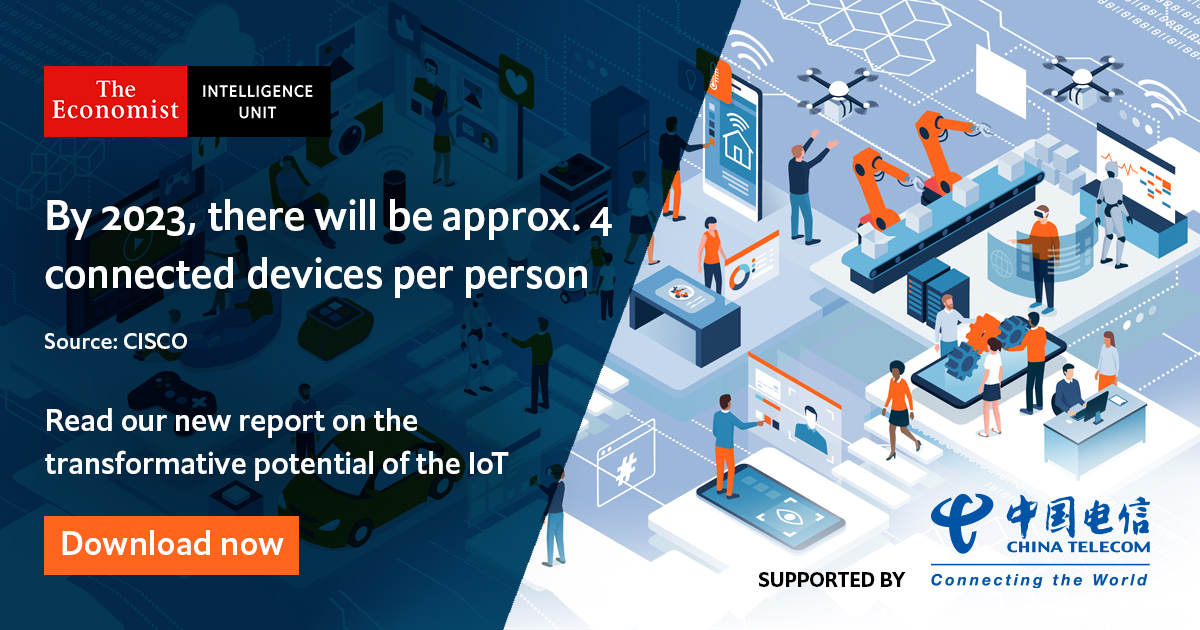The Internet of Things: Applications for Business Exploring the transformative potential of IoT
- IoT will generate US$1.1trn in revenue for companies across the world by 2025—almost 1% of projected global GDP.[1]
- Businesses adopting IoT solutions typically see 20-30% efficiency gains in their operations.[2]
- Despite this commercial opportunity, a 2019 survey showed that less than 50% of businesses had an active IoT project.[3]
- Business leaders are holding back from IoT because of concerns about security, digital infrastructure and investment.
- Solutions to these concerns exist, but firms need to collaborate to access them; bringing in the relevant expertise and creating buy-in across teams.
In 2019, The Economist identified the “second phase of the internet”—the Internet of Things (IoT).[4] Along with Artificial Intelligence and Big Data, IoT is at the centre of the digitalisation of the world economy. The excitement over IoT is driven by its ability to bring previously isolated objects, from fridges to Ferraris, online. Data collected from IoT sensors can be monitored, be fed back to instigate an action, inform the design of an algorithm or trigger a response in another connected object, maybe hundreds of miles away. The potential implications of these additional capabilities are almost limitless and business opportunities are extensive.
However, current adoption rates are lower than expected, given the commercial opportunity. Business leaders cite concerns over security and privacy, gaps in digital infrastructure and opaque regulation as holding back adoption. In many cases, these concerns are overstated and successful solutions already exist.
Low adoption is resulting in more than a loss of commercial opportunity: IoT can benefit society in addition to the bottom line. In the fight against COVID-19, IoT has been deployed across sectors to allow remote monitoring of infected patients and to scale up the manufacturing of medical devices.
The transformative potential of IoT will require even non-technology focused CEOs to be proactive and:
- Seek out collaborations with technical experts to understand how IoT may benefit their business,
- Invest in new digital infrastructure and skills as part of any new strategy, and
- Prepare for the way that IoT adoptions by competitors could disrupt their sector.
The Internet of Things: Applications for Business, supported by China Telecom, aims to show that the current lack of technological know-how and concerns about security do not have to be permanent. Support exists for those who are inspired by the potential of IoT but are unsure of the first step. This paper unpacks IoT technology, examines existing use cases across six sectors, explores the challenges currently holding back greater adoption and starts to offer solutions to these challenges.
____
[1] Global System for Mobile Communications (GSMA) Report, IoT Report, 2018
[2] McKinsey and Company, Growing opportunities in the Internet of Things, 2019
[3] PwC, IoT Survey, 2019
[4] The Economist, How the world will change as computers spread into everyday objects,2019
____
About China Telecom (Europe) Ltd.:
China Telecom (Europe) Ltd. (CTE) provides integrated telecoms and communications services as local solutions for Chinese companies and global solutions for multinational corporations. CTE’s unrivalled knowledge of the Chinese market, and regional offices across Europe, make CTE an ideal partner for European and Asian businesses looking to work in China and Asia.
















 Return to Blogs & Related News
Return to Blogs & Related News

